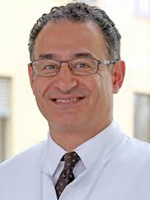Skin cancer diagnostics
To provide maximal effectiveness of skin cancer treatment it is highly important to diagnose the disease type correctly. To identify the form of skin cancer, specialists in Germany apply different diagnostic procedures. As human skin is accessible for direct inspection and taking the biomaterial for lab tests, usually doctors prescribe biopsy. Also isotopic examination is used for this purpose, while ultrasonic scan and computer tomography help to detect possible damages of inner organs.
Skin cancer treatment is performed quickly and efficiently, especially if a person came to the clinic right after noticing the first changes in birthmarks.
Before seeing a doctor you can identify the disease by the following symptoms:
- Asymmetry. If birthmark part is increased or begins to grow, you should consult a dermatologist.
- Blunt-edged birthmarks. Notches or blurred edges can point at the birthmark canceration that means high risk of melanoma development.
- Unnatural color. If the birthmark has a strange color, you should consult a doctor, especially if the birthmark is red or blue.
- The size. If the diameter of the newly appeared birthmark is more than 6 mm, it can be a developing melanoma. The treatment must be started as soon as possible to reduce the risk of complications.
In order to define a diagnosis more precisely, you should consult a dermatologist. Specialists in German clinics will perform all required tests to define the cancer type and stage. Skin cancer treatment in Germany is performed quickly and efficiently. Be ready to submit tests and give a sample of your birthmark tissue for proper analysis, when you come to a doctor.
Signs and Symptoms of Skin Cancer
There are some conditions that may or may not to develop to skin cancer and it is worth knowing some skin problems predicting cancerous lesions.
Actinic keratosis. That is itchy patches often caused by sun and, for that reason, sometimes called solar keratosis.
Cutaneous horn is a form of actinic keratosis – a keratinized growth appearing on the sun exposed areas.
Actinic Cheilitis. That is a condition when the lips seem chapped that gives to this condition a name of "farmer’s lips".
Unusual moles. Unusual means rough, big and of irregular shape.
Above skin abnormalities are not necessarily malignant but sometimes can transform into cancerous lesions. There are two main types of malignant skin disease: melanoma and non melanoma cancer and here you can find how to determine if you have one of them.
Symptoms of Non Melanoma Cancer
Among non melanoma types of cancerous diseases basal-cell carcinoma and squamous cell cancer are most common.
Basal-cell carcinoma is mostly happens on sun exposed areas of the body. It can have different appearance. Basal-cell carcinoma often looks like eczema or like scar tissue. It also could occur from inflamed ulcer. So it is important to pay attention for sores and ulcers that have not been healing for more than 3-4 weeks. In older people the face is the most affected part of the body. Basal-cell lesions rarely develop metastases.
Squamous cell carcinoma has origin in uncontrollable dividing of epithelial cells. It can develop as a lump or red patches. This type of cancer often is found on the head, face, and neck but, occasionally, it may appear on genital area. The rate of successful curing of squamous cell carcinoma is quite high as it is same like basal-cell cancer does not spread metastases very often.
Signs and Symptoms of Melanoma
Melanoma is the most dangerous kind of skin cancer as it tends developing metastases. Early it can show no symptoms but sometimes may sore or bleed. To detect melanoma timely please be attentive to below signs and symptoms.
New formations. Mostly melanoma starts as a new growth and, thus, first you have to look for any spots or molar type creations that have arisen from nothing.
Change of existing moles. Sometimes melanoma can develop based on existing moles or scars. It also might look like bruise. Check any suspicious changes of your nevi as color, size or shape change.
Where you have new grows. Mostly melanoma appears on the upper back. In women it often could be found on the legs. Rarer it can occur on the others spots.
Shape and size of the growth. If you have unknown recent growth please check if it has:
- Irregular shape
- Uneven edges
- Asymmetry
- Too big size (more than ¼ inch )
Surrounding area. If skin around the nevus is red, swollen or has other changes in pigmentation it might be a sign of melanoma.
Bleeding. If the growth keeps bleeding for a long time it is bad sign.
On latest stage of development melanoma could spread metastases but it is still difficult to determine. Among the most obvious symptoms you could name:
- Swollen lymph nodes
- Lumps and thickening under the skin
- Overall weakness
If melanoma detected in early stage it can be successfully removed by surgery without any complications, but in latest stages it is difficult for healing and could cause metastases in bones, liver and brain.
Checking for Skin Cancer
The risks of malignant skin disease increases with age and after 50 it is recommended to make regular checking for signs of the cancerous disease. It is possible to do this independently of with help of some of relative or a doctor.
You should put your close off and check your entire body with a mirror. For some of difficultly reachable area you can use a hand mirror or ask for help your partner or close people. Look attentively for above mentioned signs of new or changed growth. If you have any suspicions, see your doctor.
Detection and Diagnosis in Germany
If you found any of above symptoms of abnormal growth on your skin it is strictly recommended to make an appointment with a dermatologist or with a specialist in field of skin cancer. Please consult with highly professional physicians of international class presented by GMG.
With GMG you can choose a doctor or clinic in few simple steps: checking, comparing, and applying. You have a wide range of options from making an appointment with a luminary at treating of skin cancer to having examination in multidisciplinary medical center in Germany. You only have to make a call and you will find your best doctor shortly. To find a way to healthy life is easy.
Modern skin cancer treatment methods
Different methods of removing malignant skin tumors are applied in German clinics. As a rule, they are used in complex, and the most effective one is surgery.
With the aim of highly qualified dermatologists and surgeons it is possible to resect even the smallest tumors before they begin to grow actively and spread metastases through the blood. German surgeons offer a few types of surgeries for skin cancer treatment.
Laser surgery
Using the newest equipment it is possible to remove any tumor including melanoma. Skin cancer treatment can include chemotherapy or medication therapy to deactivate the tumor development and prevent metastases.
Laser surgery is highly efficient, as it allows removing the tumor by burning out the tissue on the required depth. Such skin cancer treatment becomes possible with the aim of experienced, highly qualified doctors who can precisely define the required depth of laser dissection.
Traditional surgery in skin cancer treatment
A scalpel together with magnifying equipment is applied rather often. This method is recommended in cases when the tumor is located in zones with high risk of complications or where it is impossible to apply laser. A surgical method is the major one for the treatment of skin cancer at any stage. After thorough diagnostics, defining the location depth and other features of melanoma an experienced surgeon can, fully dissect the cancerous tissue.
If melanoma has already affected lymph glands, it is reasonable to apply excessive dissection. Such surgery is wider than a standard one. The advanced stages of skin cancer require a complex of surgeries.
Mohs method – an efficient surgical approach in skin cancer treatment
Such surgery implies layer-by-layer resection of the damaged skin fragments. Each dissected layer is passed to laboratory for analysis. This way it is possible to define a depth of melanoma ingrowth and dissect all layers that contain cancerous cells. This is highly complicated treatment method that requires special skills and experience from a surgeon.
On the advanced stages skin cancer treatment requires radiotherapy to prevent the diffusion of cancerous cells into bone structures. Chemotherapy helps to prevent metastases development, while immune therapy helps to strengthen health and prevent the disease relapse.
If you want to undergo skin cancer diagnostics and treatment in Germany and looking for proper specialists, please contact us. We will help you to find an excellent oncology surgeon.








 Loading ...
Loading ...


